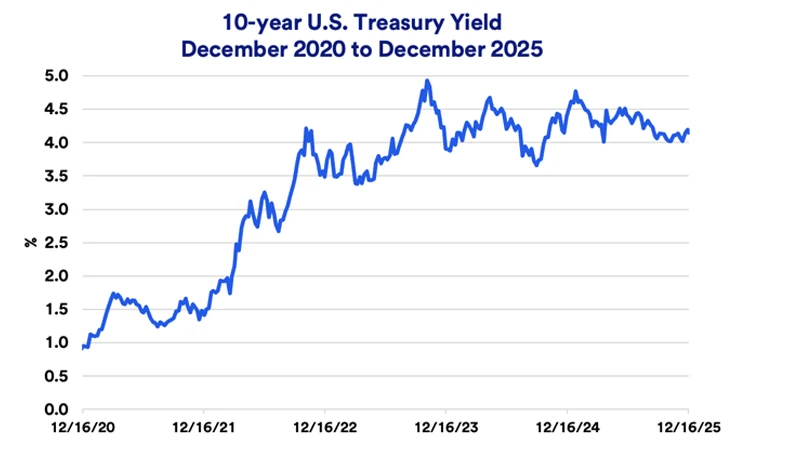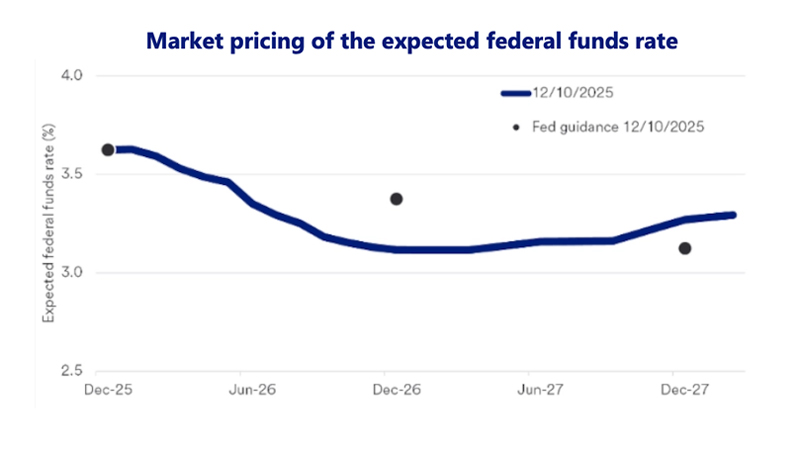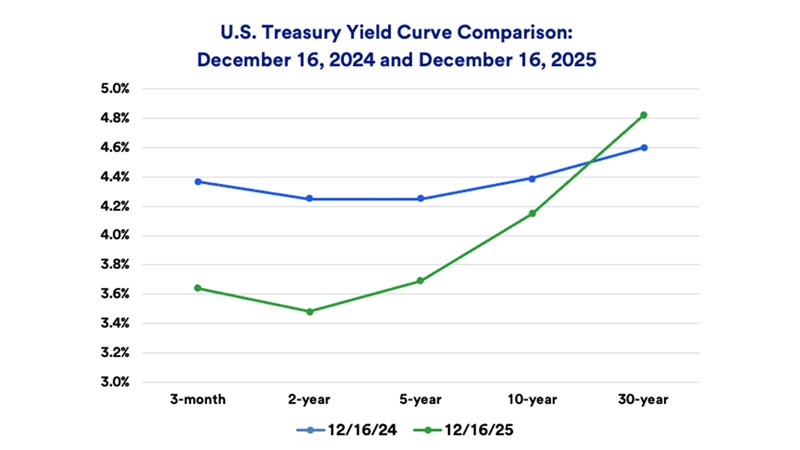Capitalize on today’s evolving market dynamics.
With markets in flux, now is a good time to meet with a wealth advisor.

Federal Reserve (Fed) rate cuts lowered short yields, but growth and inflation expectations keep longer-term yields rangebound near 4.00-4.25%.
Inflation remains above target, while tariffs show limited pricing impact so far. Policy decisions remain central to bond-market direction.
Fiscal deficits and Treasury issuance shape longer-term yields; diversification and selective higher-yield exposure can enhance income and portfolio resilience.
Bonds can play an important role in a diversified portfolio, and today’s environment offers a clearer opportunity to lock in income than investors have seen in years. Investors can also expand beyond U.S. Treasuries to seek incremental yield, although each sector introduces different risks and tradeoffs. Recently, 10-year Treasury yields have generally stayed in a 4.00 to 4.25% range, while other bond types offer additional yield in exchange for credit, liquidity, or interest rate risk.1

Several forces drive yields, and investors benefit when they separate bond market forces by maturity. For example, central bank interest rate policy targets and market rate expectations typically dominate shorter-term yields because central banks directly influence overnight financing rates. Meanwhile, longer-term yields respond more to economic growth and inflation expectations, since investors weigh the opportunity cost of holding bonds versus deploying capital elsewhere. Finally, credit quality and bond supply impact the yield premium investors demand to purchase bonds, particularly outside the Treasury market.
“Federal Reserve (Fed) rate cuts pulled short-term bond yields lower. However, longer-term bond yields remained rangebound in recent months due to lower inflation expectations offsetting stronger economic growth expectations,” notes Bill Merz, head of capital markets research with U.S. Bank Asset Management Group.
The Fed reduced interest rates to acknowledge softer labor market conditions even as inflation stayed elevated, and the Fed's projections show a mix of higher growth expectations in 2026 alongside lower inflation. That combination aligns with broader market forecasts and an outlook for continued strong corporate earnings growth. Investors watched these crosscurrents closely because they help explain why short rates moved lower while longer rates stayed constrained in a tight range.
“Economists predicted modestly higher inflation this year, and recent data confirmed those forecasts. Consensus now points to a gradual slowdown in inflation,” says Merz. “Tariff price pressures appeared in business surveys and accelerating core goods prices, but these effects haven’t been extreme.”
Even so, inflation remains above the Fed’s target, which keeps policy decisions highly relevant for bond investors. Year-over-year inflation, as measured by the Consumer Price Index (CPI), rose slightly to 3.0% in October, well above the Fed’s 2% target.2 That persistence matters because it can influence both the pace of future rate cuts and how far longer-term yields can fall without a more decisive inflation downtrend.
Policy decisions and fiscal dynamics can exert competing forces on bond yields. At its December meeting, the Federal Open Market Committee (FOMC) cut the federal funds target rate by 0.25% to a range of 3.50 to 3.75%. Median Fed member projections anticipate another 2026 cut, although investors expect two to three additional cuts.3 This gap between projections and market pricing can create near-term volatility in bond markets

Fiscal conditions also shape the supply backdrop for Treasuries, which can pressure yields higher if borrowing needs rise. “Treasury Secretary Scott Bessent does not plan to increase auction sizes for longer maturities,” says Merz. “Rather, the Treasury indicates it will issue more short-term bills, where heavy issuance is unlikely to disrupt broad bond market pricing in the near term.”
Meanwhile, the “One Big Beautiful Bill Act” extends current tax rates, adds new tax cuts, and trims spending only modestly, which the Congressional Budget Office estimates could increase the federal debt by $3.4 trillion by 2034. However, large tariff increases instituted in 2025 can partially offset additional spending if maintained in 2026 and beyond.4 Over time, higher borrowing could lift Treasury issuance and potentially push interest rates higher, particularly if investors demand more compensation for the increased bond supply and fiscal uncertainty.
“Recently, rate cuts pulled Treasury yields lower,” notes Merz. “Over the long run, bond buyers want to see federal cash flow support bond principal and interest payments, which would suggest lower spending or higher taxes.” Otherwise, they may demand higher yields (lower prices) to compensate for higher risks, according to Merz.
“Treasury indicates it will issue more short-term bills, where heavy issuance is unlikely to disrupt broad bond market pricing in the near term.”
Bill Merz, head of capital markets research with U.S. Bank Asset Management Group
As these forces interact, the yield curve, which compares Treasury yields across maturity dates, has moved closer to a more typical shape. Normally, longer-term bonds offer higher yields than shorter-term bonds to compensate investors for committing their money for extended periods. However, Fed interest rate policy, which influences shorter maturities more than longer maturities, can cause yield curve changes.
The yield curve inverted, meaning short term yields were higher than long term yields, from mid-2022 to later in 2024 as restrictive policy pushed short rates above long rates and markets anticipated eventual cuts. Currently, the 10-year Treasury yields 0.67% more than the 2-year Treasury, compared with an average spread of nearly 0.80% since 1977.1 These shifts matter for portfolio construction because they influence how much investors get paid to extend maturity and accept interest rate risk.

Against this backdrop, investors can still position bond portfolios to balance income, diversification, and risk management. Investors should emphasize diversification, avoid overconcentration in cash or very short-term instruments, and incorporate higher yielding bonds to enhance income while managing tariff-related inflation risk. Beyond bonds, global infrastructure and equities can also benefit from ongoing economic expansion, particularly if earnings growth remains supportive. “Economic conditions can support continued earnings growth, creating favorable equity and real asset return opportunities,” says Merz.
Talk to your wealth professional for more information about how to position your fixed income investments consistent with your goals, investment time horizon, risk tolerance and tax profile.
Investments in fixed income securities are subject to various risks, including changes in interest rates, credit quality, market valuations, liquidity, prepayments, early redemption, corporate events, tax ramifications and other factors. Investment in fixed income securities typically decrease in value when interest rates rise. This risk is usually greater for longer-term securities. Investments in lower-rated and non-rated securities present a greater risk of loss to principal and interest than higher-rated securities.
The municipal bond market is volatile and can be significantly affected by adverse tax, legislative or political changes and the financial condition of the issues of municipal securities. Interest rate increases can cause the price of a bond to decrease. Income on municipal bonds is generally free from federal taxes but may be subject to the federal alternative minimum tax (AMT), state and local taxes.
Bond yields respond to changes in the economy. When the economy grows quickly and inflation rises, bond yields increase. If the Federal Reserve raises the federal funds target rate, bond yields also climb. For example, when inflation surged in 2021, the Federal Reserve raised rates in early 2022, causing bond yields to rise. Conversely, when the economy slows or inflation stays low, bond yields drop or remain steady. In mid-2024, bond yields fell again after the Fed cut rates in September 2024, and longer-term yields have fluctuated since.
Interest rates directly affect bond prices. When interest rates rise, bond prices fall; when rates drop, bond prices rise. This relationship, known as interest rate risk, means that if you sell a bond before it matures, you may receive more or less than its face value depending on current rates. If you hold a bond to maturity, you typically receive its face value, provided the issuer doesn’t default.
You can find better return opportunities when bond yields are high. Higher yields generate more income and may reduce interest rate risk, since rates are less likely to rise much further. However, even when rates are low, bonds can still play an important role in a diversified portfolio.
The S&P 500’s recent rollercoaster performance has investors wondering what lies ahead for the stock market.
We can partner with you to design an investment strategy that aligns with your goals and is able to weather all types of market cycles.